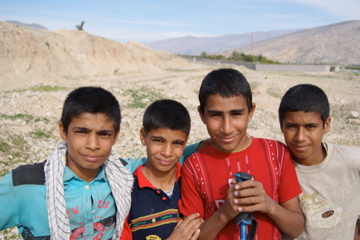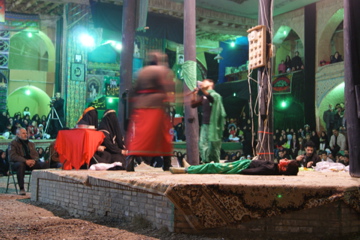
This is part 2 in a 4 part series.
Dasht-e-Kavir
10 kilometers outside of Tehran city limits the landscape changes abruptly from mountains to low rolling hills. I climbed the red dirt slopes, sinking at times up to my knees in the soft powdery sand. By the middle of the day it was hot and walking across the open plain sweat dripped from my nose and soaked my clothes.

In my path stood a number of nuclear sites. Just prior to my entry into the country it had been revealed that the Iranian government had been keeping secret a nuclear facility just outside Qom. As well as a not so secret underground nuclear reactor near Natanz and enrichment sites in Esfahan directly in my path I was somewhat apprehensive. Wherever I seemed to find myself at dusk for the next week, I was overlooked by military installations, be they checkpoints, observation towers or artillery placements. Strategically placed, they had a fine view over the rolling hills and small valleys within which I needed to pitch my tent. My only option was to wait until the sun had fully set and in the fast fading light throw my tent up and eat my dinner in darkness, careful not to use my headlamp. I lay awake some evenings imagining an elite group of Revolutionary Guards on patrol, coming across my camp and hauling me off for some serious questioning. What on earth could I be doing there? It was not a beautiful area by any stretch. Harsh, unforgiving and rock strewn, I had better have a pretty good reason for lurking so close. Fortunately my fantasies never eventuated and my path across south the dry plateau toward Qom. If it were not for the single multi-lane freeway some kilometres to my left or the telecommunications towers atop faraway peaks I was alone.
Natanz
I stumbled into the village of Natanz late one evening, limping on my bruised and damaged feet. A fast pace with heavy pack over rough terrain in order to avoid suspicion had caught up with me. I did not want to risk camping in the open plain so close to where I had just passed signs proudly announcing the nuclear facility. I was invited by Adi, a local English tutor, that evening to witness Islamic religious theatre as part of the commemoration of the death in the Battle of Karbala of Imam Hussain ibn Ali, an important figure in Shia Islam. I happened to be walking across Iran during a month of worship in his honor that would culminate in Ashura - a day of mourning and self-reflection. Led down dusty alleyways amongst mud brick dwellings many hundreds of years old, we pushed through a set of massive, heavy wooden doors, strengthened with steel, into an arena known as a hoseinieh built specifically for the performance of ceremonies during the period.

The sights, sounds and smells that greeted me in the hoseinieh came from an ancient time. The room was a huge complex with a roof of canvas covered in Islamic motifs. Thick, acrid smoke hung in the air and straw covered the floor. Hundreds of black-cloaked women sat and whispered to each other on one side of the hall or in stalls above, while stoic black-shirted men occupying the other spoke with serious faces. Children ran between the crowds of people, laughing and screaming. On a small raised platform actors played out the death of the Imam and his comrades in a performance known as ta'ziyeh. The echo of music and yelling reverberated throughout the hall as the players met in mock battle. Throats were cut and bodies fell to the earthen floor in pools of fake blood. It was an intimidating scene, yet powerful and heartfelt. I felt privileged to witness it.
At performance end, my hosts led me to another hall on the other side of town. Here, a similar scene had just unfolded. Now, men, young and old, were participating in Zanjir Matam, self-flagellation with chains. Kids as young as ten, repeatedly swung heavy chain links attached to a wooden handle, striking their backs. The more fervent among them swung with ferocity. The act looked brutal but I was encouraged to try it out for myself. Giving the Zanjir a good swing on to my back, I found it no more painful than a hard slap. Sitting down, my shoulders blades flushed with blood and prickling from the chain strikes, I felt conspicuous in my expedition garb and drew more than a few hardened stares from the crowd. But the unease was broken by the wide smile and crushing handshake of Mr. Kazemi, in charge of the event. A plate, piled high with rice, meat and beans was shoved into my hands by a young man conscripted to wait on the crowd, along with a juice carton and the order given to eat. I happily obeyed.
Much later, in a quiet corner of the hall, I sat cross-legged with a group of old men on a dusty carpet drinking tea, sugar cubes between our teeth. Like any such gathering we dissected the world and it's problems. After a short time, discussion inevitably turned towards my thoughts of their country. I answered with no lie and professed my great affection for what I had experienced so far. Without need for prompting, a number of the men gave me their view of the west, most specifically the UK and US. They had no bad word to say towards the citizens of these countries. Indeed, it seemed most had relatives happily living the American dream in California! In what came to be a common theme throughout my journey, the biggest grievance they felt was the way in which their country was viewed and to a degree treated by the West. Their day to day existence impacted by sanctions and being included on a list with Osama Bin Laden does not make one feel great.
This is part 2 of a 4 part series.